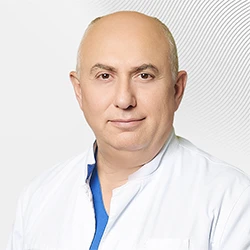Blepharoptosis – drooping of the upper eyelid
The upper eyelid is lifted by the levator muscle, which is innervated by the oculomotor nerve. Therefore, the causes of drooping of the upper eyelid are almost always associated either with an anomaly of the muscle that raises the eyelid, or with pathology of the oculomotor nerve.
To diagnose drooping of the upper eyelid, the height of the eyelid position and the width of the eye slit are measured, the symmetry and completeness of the eyelid movements of both eyes are checked, the mobility of the eyeballs and eyebrows, the strength of the levator muscle, the position of the head and other functional indicators are evaluated.
Normally, the iris of the eye is closed by the edge of the upper eyelid by about 1.5 mm. Ptosis (or blepharoptosis) is referred to if the eyelid falls below the upper edge of the iris by 2 mm or more, or is located below the eyelid of the other eye when compared. Drooping of the upper eyelid can be both congenital and develop during life, therefore blepharoptosis is quite common among both children and adults.
Drooping of the upper eyelid is not only a significant cosmetic defect, but also impedes the normal development and functioning of the eye, causing mechanical vision difficulties or functional blindness when the eyelid covers the viewing line.
Blepharoptosis is divided into congenital and acquired, according to the severity of the drooping eyelid into partial (the edge of the eyelid covers the upper third of the pupil), incomplete (the edge of the eyelid is lowered to half of the pupil) and complete (the upper eyelid covers the entire pupil). Unilateral ptosis is most common (69%), less often bilateral (31%).
Congenital blepharoptosis is often combined with strabismus, epicanthus (covering of the lacrimal tubercle at the inner corner of the eye with a vertical skin fold, paresis of the superior rectus muscle. The constant covering of the eyeball with the eyelid eventually leads to the development of amblyopia ("lazy eye"). With acquired drooping of the upper eyelid, diplopia (double vision of visible objects), protrusion of the eyeball (exophthalmos), or vice versa, a deeper location of the eyeball in the orbit (enophthalmos), and impaired corneal sensitivity are often noted.
False or apparent drooping of the upper eyelid is pseudoptosis, it occurs with excess skin on the upper eyelid (blepharochalasis), strabismus and hypotension of the eyeball.
Due to the various mechanisms leading to drooping of the upper eyelid, diagnosis and correction of blepharoptosis often require joint management of the patient by an ophthalmologist, neurologist and plastic surgeon.
The treatment of upper eyelid ptosis is aimed at eliminating functional pathology and correcting cosmetic defects. In the case of neurogenic drooping of the upper eyelid, the underlying pathology is treated.
With congenital drooping of the upper eyelid, as well as the lack of effect from conservative therapy of acquired ptosis for 6-9 months, surgical methods are resorted to. The timing of correction of congenital blepharoptosis is set individually – partial drooping of the upper eyelid is operated at 13-16 years of age; complete ptosis, due to the likelihood of developing amblyopia ("lazy eye"), it is advisable to eliminate it at preschool age from 3 to 5 years.
The standard blepharoplasty operation consists in shortening the muscle that lifts the upper eyelid, or in shortening the aponeurosis of the levator muscle and fixing its lower edge.
In our clinic, preference is given to such a method of surgical treatment as frontal suspension. In this case, the Hildreth-Silver suture technique is used, in which the intervention is performed through micro-incisions in the skin so that no postoperative scars remain. The operation is less traumatic and has a shorter recovery period. Such ophthalmological operations are performed for our patients under short-term general anesthesia.
Suture technique for correcting ptosis is indicated for young children, as it prevents visual impairment, and is recommended for elderly and infirm patients and in case of unsuccessful levator resection. Seam correction or removal can be performed at any time.
The aesthetic and functional result of blepharoptosis correction with the correct surgical tactics is usually preserved for life. When the upper eyelid is lowered due to paralysis of the nerves innervating the muscles of the eye (ophthalmoplegia), treatment allows for a partial effect.
If your child has been diagnosed with drooping of the upper eyelid, it is necessary to immediately carry out a comprehensive diagnosis and begin treatment. The lack of treatment for ptosis can lead to the development of various complications, such as amblyopia, visual impairment, functional blindness, and significantly reduces the child's quality of life. In school-age children, ptosis can cause psychological problems and poor academic performance.
At the EMC Children's Clinic, ophthalmologists will quickly and painlessly diagnose, select the optimal treatment for the child, and, if necessary, perform a minor traumatic operation.
The author of the article is Viktor Makarov, PhD, ophthalmic surgeon.
Why the EMC
The first and only clinic in Russia, created in the image of the world's leading clinics
EMC is a multidisciplinary center offering patients a high level of medical services and a personalized approach
Worldwide recognition and awards
 Learn more
Learn more
Worldwide recognition and awards
 Certificates and licenses
Certificates and licenses
Make an appointment for a consultation
Specify your contacts and we will contact you to clarify the details
Reviews
and new products of the EMC





.webp)




.webp)
